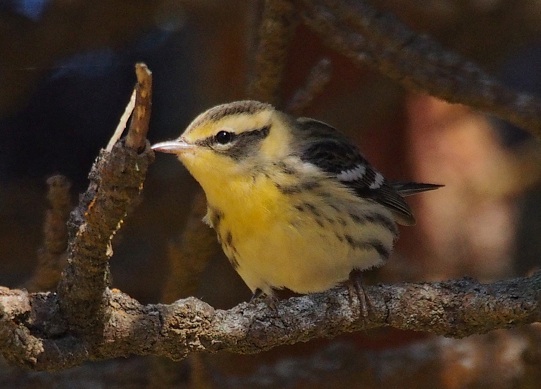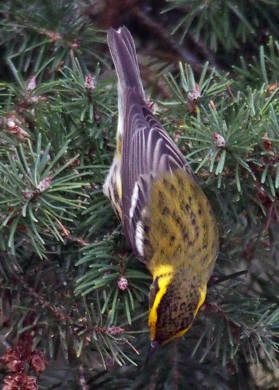A practical guide to bird watching in Sonoma County, California
(Unless otherwise indicated, all phone numbers are in the 707 area code)
A practical guide to bird watching in Sonoma County, California
(Unless otherwise indicated, all phone numbers are in the 707 area code)


One of the more common warblers that appear in Sonoma County mostly during spring and fall migration and over the winter months--and one of the prettiest. Usually arrives here in numbers in mid- to late September. Numbers begin to thin again in mid-April through early May the following year. Least common in the county in June, July, and August. Perhaps most common during fall migration (mid-September to mid-October). Found in coniferous forests as well as oak and mixed woodland, often near water. Tends to stay fairly high in trees. May be solitary or in mixed flocks with chickadees, bushtits, nuthatches and similar birds. Winters south to highlands in Mexico through Costa Rica.
Recognized by its bright yellow face with black cheek and yellow spot under the eye. The only warbler at all common in Sonoma County with this facial pattern. Other warblers with a similar facial pattern are mostly rare vagrants in the county, and none combine this pattern precisely with Townsend's Warbler's other coloration. Look for: the dark cap and nape; dark cheek patch with yellow under the eye; the lightly black-streaked olive back (although the streaks can be faint or simply hard to see because of lighting or rapid movement of the bird through obscuring foliage); black throat with yellow upper breast (but note that first fall birds will show only a hint of the black at the throat or none at all in the case of first fall females--see photo below); white belly and undertail coverts; black streaking on flanks; and two distinct white wing bars. Cap and cheek patch are nearly black in fully adult male, lighter and somewhat greenish in females and young birds.
Similar species include Hermit Warbler (Setophaga occidentalis, formerly Dendroica occidentalis), but that bird is markedly less common in the county. Hermit Warbler has a clear yellow face (lacking the cheek patch) and a plain white belly with no streaking on the flanks (see photo below). Note, however, that Townsend's Warbler and Hermit Warbler are known to hybridize, creating intermediate forms. The Peterson specialty guide to warblers has good illustrations. Other somewhat similar warblers are birds normally confined to the Eastern United States, and are therefore unlikely in the county--although just about anything can turn up as a stray. The similar-looking Black-throated Green Warbler (Setophaga virens, formerly Dendroica virens) has been reported sporadically in neighboring counties, but I find no records for Sonoma County. Blackburnian Warbler (Setophaga fusca, formerly Dendroica fusca), is somewhat similar in appearance. It has been reported in the county a handful of times over the years, but is very unlikely.
As of July 2011, the genus Dendroica disappeared. These birds are now assigned to the genus Setophaga, but most references current at the time of writing (2012) will be around for a while, so expect to see this bird as Dendroica townsendi for some time to come, with newer sources using the new name, Setophaga townsendi.
English synonyms: None
Townsend’s Warbler in other languages--German: Townsend Waldsänger; Spanish: Chipe de Townsend, Chipe Negroamarillo, Reinita Bicolor, Reinita de Townsend; French: Fauvette de Townsend, Paruline de Townsend; Russian: Пугливый лесной певун; Chinese: 黄眉林莺; Japanese: タウンセンドアメリカムシクイ(taunsendo amerikamushikui)
(Language information from Avibase, Birds of Europe (Mullarney et al, Princeton Field Guide Series), and Birds of Asia (Mark Brazil, Princeton Field Guide Series).
Further reading:
Bolander and Parmeter, Birds of Sonoma County California, rev. ed., 2000, p. 105
Brinkley, National Wildlife Federation Field Guide to Birds of North America, 2007, p. 386
Dunn and Alderfer, eds., National Geographic Field Guide to the Birds of North America, 5th ed., 2006, p. 384
Dunn and Alderfer, eds., National Geographic Field Guide to the Birds of North America, 6th ed., 2011, p. 436
Dunn and Garrett, Warblers: Peterson Field Guides, 1st ed., 1997, pp. 307-315, pl. 14 (spanning pp. 70-71)
Dunne, Pete Dunne’s Essential Field Guide Companion, 2006, p. 544-545
Ehrlich, Dobkin, and Wheye, The Birder's Handbook, paperback edition, 1988, p. 520
Fix and Bezener, Birds of Northern California, 2000, p. 316
Floyd, Smithsonian Field Guide to the Birds of North America, 2008, p. 393
Kaufman, Field Guide to Birds of North America, 2000, p. 316
Kaufman, Advanced Birding, 1990, pp. 229-232 (notes on identifying warblers generally)
Kaufman, Field Guide to Advanced Birding, 2011, pp. 390-411 (notes on warblers generally), pages 11, 124, 405
Lukas, Bay Area Birds: From Sonoma County to Monterey Bay, 2012, p. 244
Parmeter and Wight, Birds of Sonoma County California, Update (2000-2010), 2012, p. 65
Peterson, Field Guide to Birds of Western North America, 4th ed., 2010, p. 310
Peterson, Western Birds, 3rd ed., 1990, p. 290
Sibley, Field Guide to Birds of Western North America,1st ed., 2003, p. 374
Stephenson and Whittle, The Warbler Guide, 2013, pp. 440-445
Stokes, Stokes Field Guide to the Birds of North America, 1st ed., 2010, p. 613
Stokes, Stokes Field Guide to Warblers, 2004, pp. 64-65
Vuilleumier, American Museum of Natural History, Birds of North America: Western Region, 2011, p. 358
Voice: Cornell Lab of Ornithology: All About Birds--Townsend's Warbler
© Colin Talcroft, 2009, 2010, 2011, 2012, 2013, 2014
Unless noted, all photos by the author. If you would like to use one of my images, please ask for permission for non-commercial use with proper credit or commercial use with proper compensation.
Townsend's Warbler, Sebastopol, September 27, 2011
Probably a first-fall male (note lack of full black markings at throat)

Townsend's Warbler, Spring Lake, Santa Rosa, November 12, 2011

For comparison: Hermit Warbler, Owl Canyon, Bodega Bay, August 29, 2011
Probably a first-fall female (note absence of black at throat)

Townsend's Warbler, Spring Lake, Santa Rosa, November 12, 2011

Townsend's Warbler
Setophaga townsendi
1990-2013 Sonoma County data. Graph provided by eBird (www.ebird.org), generated September 8, 2013
EBird-reported occurrence in Sonoma County



For comparison: Blackburninan Warbler, near Chimney Rock, Point Reyes (Marin County)
September 28, 2013

Townsend's Warbler, Sebastopol, December 29, 2013
A good view of the black-streaked olive back and crown